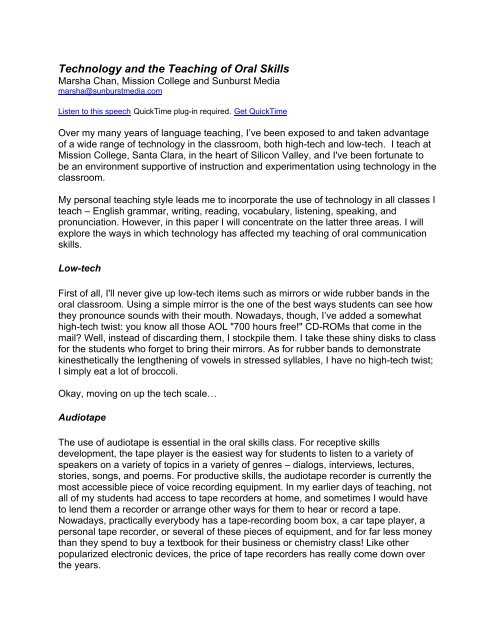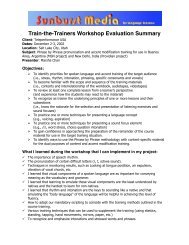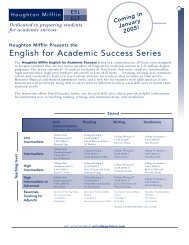Technology and the Teaching of Oral Skills - Sunburst Media
Technology and the Teaching of Oral Skills - Sunburst Media
Technology and the Teaching of Oral Skills - Sunburst Media
Create successful ePaper yourself
Turn your PDF publications into a flip-book with our unique Google optimized e-Paper software.
<strong>Technology</strong> <strong>and</strong> <strong>the</strong> <strong>Teaching</strong> <strong>of</strong> <strong>Oral</strong> <strong>Skills</strong>Marsha Chan, Mission College <strong>and</strong> <strong>Sunburst</strong> <strong>Media</strong>marsha@sunburstmedia.comListen to this speech QuickTime plug-in required. Get QuickTimeOver my many years <strong>of</strong> language teaching, I’ve been exposed to <strong>and</strong> taken advantage<strong>of</strong> a wide range <strong>of</strong> technology in <strong>the</strong> classroom, both high-tech <strong>and</strong> low-tech. I teach atMission College, Santa Clara, in <strong>the</strong> heart <strong>of</strong> Silicon Valley, <strong>and</strong> I've been fortunate tobe an environment supportive <strong>of</strong> instruction <strong>and</strong> experimentation using technology in <strong>the</strong>classroom.My personal teaching style leads me to incorporate <strong>the</strong> use <strong>of</strong> technology in all classes Iteach – English grammar, writing, reading, vocabulary, listening, speaking, <strong>and</strong>pronunciation. However, in this paper I will concentrate on <strong>the</strong> latter three areas. I willexplore <strong>the</strong> ways in which technology has affected my teaching <strong>of</strong> oral communicationskills.Low-techFirst <strong>of</strong> all, I'll never give up low-tech items such as mirrors or wide rubber b<strong>and</strong>s in <strong>the</strong>oral classroom. Using a simple mirror is <strong>the</strong> one <strong>of</strong> <strong>the</strong> best ways students can see how<strong>the</strong>y pronounce sounds with <strong>the</strong>ir mouth. Nowadays, though, I’ve added a somewhathigh-tech twist: you know all those AOL "700 hours free!" CD-ROMs that come in <strong>the</strong>mail? Well, instead <strong>of</strong> discarding <strong>the</strong>m, I stockpile <strong>the</strong>m. I take <strong>the</strong>se shiny disks to classfor <strong>the</strong> students who forget to bring <strong>the</strong>ir mirrors. As for rubber b<strong>and</strong>s to demonstratekines<strong>the</strong>tically <strong>the</strong> leng<strong>the</strong>ning <strong>of</strong> vowels in stressed syllables, I have no high-tech twist;I simply eat a lot <strong>of</strong> broccoli.Okay, moving on up <strong>the</strong> tech scale…AudiotapeThe use <strong>of</strong> audiotape is essential in <strong>the</strong> oral skills class. For receptive skillsdevelopment, <strong>the</strong> tape player is <strong>the</strong> easiest way for students to listen to a variety <strong>of</strong>speakers on a variety <strong>of</strong> topics in a variety <strong>of</strong> genres – dialogs, interviews, lectures,stories, songs, <strong>and</strong> poems. For productive skills, <strong>the</strong> audiotape recorder is currently <strong>the</strong>most accessible piece <strong>of</strong> voice recording equipment. In my earlier days <strong>of</strong> teaching, notall <strong>of</strong> my students had access to tape recorders at home, <strong>and</strong> sometimes I would haveto lend <strong>the</strong>m a recorder or arrange o<strong>the</strong>r ways for <strong>the</strong>m to hear or record a tape.Nowadays, practically everybody has a tape-recording boom box, a car tape player, apersonal tape recorder, or several <strong>of</strong> <strong>the</strong>se pieces <strong>of</strong> equipment, <strong>and</strong> for far less moneythan <strong>the</strong>y spend to buy a textbook for <strong>the</strong>ir business or chemistry class! Like o<strong>the</strong>rpopularized electronic devices, <strong>the</strong> price <strong>of</strong> tape recorders has really come down over<strong>the</strong> years.
In my ESL speaking <strong>and</strong> pronunciation classes, students tape record interviews withnative speakers <strong>and</strong> record <strong>the</strong>ir own voices on tape on a regular basis. Audiotape isstill <strong>the</strong> most convenient means <strong>of</strong> capturing <strong>the</strong>ir voices for evaluation <strong>and</strong> analysis. Forme, one <strong>of</strong> <strong>the</strong> outcomes <strong>of</strong> using this technology is that I collect baskets <strong>and</strong> baskets <strong>of</strong>tapes, <strong>and</strong> I spend a fair amount <strong>of</strong> time listening to <strong>the</strong>m, analyzing students’ spokenEnglish, <strong>and</strong> recording <strong>and</strong> writing down my own comments <strong>and</strong> corrections. I alsospend time recording new material for listening, speaking, <strong>and</strong> pronunciation practice<strong>and</strong> testing. The positive side for students is that <strong>the</strong>y receive individualized instruction<strong>and</strong> guidance from someone who is a model speaker, so ideally both <strong>the</strong> message <strong>and</strong><strong>the</strong> medium are valuable <strong>and</strong> promote <strong>the</strong>ir learning.VideotapeVideotape is a step up from audiotape. First <strong>of</strong> all, playing prerecorded tapes provides<strong>the</strong> audiovisual information that helps students observe, underst<strong>and</strong>, <strong>and</strong> imitate oralcommunication, from language expressions <strong>and</strong> sentence structure to lip shape, facialexpressions, gestures <strong>and</strong> distance between speakers, not to mention o<strong>the</strong>r cultural,behavioral, <strong>and</strong> sociological aspects <strong>of</strong> language. Fortunately, a VCR is stationed invirtually every classroom at Mission College, so all I have to do is select, record, borrowor buy <strong>the</strong> appropriate material on videotape <strong>and</strong> insert it in <strong>the</strong> classroom player.Using a video camera to record students' interactions <strong>and</strong> oral presentations requiresmore set-up – I have to reserve <strong>the</strong> camera, which is fixed on a rolling tripod, pick it upfrom <strong>the</strong> audiovisual department in ano<strong>the</strong>r building, <strong>and</strong> return it after class – but it'sworth doing because, if a picture speaks a thous<strong>and</strong> words, a moving picture speaks amillion. Videotape provides speakers with a view <strong>of</strong> <strong>the</strong>mselves that <strong>the</strong>y don't o<strong>the</strong>rwisehave, <strong>and</strong> it gives <strong>the</strong>m a stronger basis for evaluating <strong>the</strong>ir performance <strong>and</strong> settinggoals for future learning.Language LabAno<strong>the</strong>r technology that is invaluable for <strong>the</strong> promotion <strong>of</strong> listening <strong>and</strong> speaking skills is<strong>the</strong> interactive language lab. I have to reveal that <strong>the</strong> language lab at my college isfalling apart – <strong>the</strong> tape recorders are failing one by one, <strong>the</strong> headsets are broken, <strong>the</strong>main console is no longer functional – it's an obsolete pre-DOS system that is beyondrepair <strong>and</strong> that we have not been able to replace due to <strong>the</strong> high expense. BUT thatdoes not stop me from using it, arranging technological workarounds for it, orproselytizing its use. Why? Because <strong>the</strong> language lab does many things that benefit oralskills development better than <strong>the</strong> regular non-tech classroom. For example, in choralrepetition drills, students can concentrate on <strong>the</strong> model (teacher or tape) with far lessinterference from <strong>the</strong> voices <strong>of</strong> classmates, <strong>the</strong>y can concentrate on <strong>the</strong> sound <strong>of</strong> <strong>the</strong>irown voice, <strong>and</strong> <strong>the</strong>y can record both <strong>the</strong> model <strong>and</strong> <strong>the</strong>ir own voice for later comparison<strong>and</strong> practice. They can't take home our voices from <strong>the</strong> non-tech classroom.Ano<strong>the</strong>r function, pairing <strong>and</strong> grouping students <strong>and</strong> assigning speaking tasks, greatlyincreases students' speaking <strong>and</strong> listening practice. Since <strong>the</strong>y may be r<strong>and</strong>omlygrouped with students sitting in ano<strong>the</strong>r part <strong>of</strong> <strong>the</strong> lab, <strong>the</strong>y cannot rely on bodylanguage; <strong>the</strong> only way <strong>the</strong>y can communicate is by really listening <strong>and</strong> speaking to
<strong>the</strong>ir partners. The teacher can join, monitor <strong>and</strong> help groups <strong>of</strong> students with a touch <strong>of</strong>a button on a screen, <strong>and</strong> faster than physically traveling around <strong>the</strong> classroom fromgroup to group. Regrouping is done electronically from <strong>the</strong> teacher's console, so <strong>the</strong>re'sno lost time from students having to pick up <strong>the</strong>ir book bags <strong>and</strong> move to a new seat.A third function <strong>of</strong> <strong>the</strong> language lab that is superior to a non-tech classroom is testing.In <strong>the</strong> language lab, you can have all students record oral responses simultaneously ontape to interview questions or scenarios or pictures – whatever kind <strong>of</strong> prompt issuitable for <strong>the</strong> pr<strong>of</strong>iciency level <strong>of</strong> <strong>the</strong> students <strong>and</strong> <strong>the</strong> specific skills you're trying totest. And <strong>of</strong> course, you can administer listening tests better; <strong>the</strong>re's a lot lessinterference from ambient noises such as planes flying overhead or power lawnmowerscutting <strong>the</strong> grass outside <strong>the</strong> classroom. Clearly, being able to use <strong>the</strong>se functions <strong>of</strong> <strong>the</strong>language lab require more investment <strong>of</strong> time <strong>and</strong> energy on <strong>the</strong> teacher's part thansimply bringing a tape player to class or not using any technology at all. In myexperience, this investment has great rewards in students' gain in accuracy <strong>and</strong> fluency.VoicemailYou're probably wondering, what kind <strong>of</strong> technology is good for students but not sotime-consuming for teachers? To get students to do oral assignments that I can hear<strong>and</strong> assess but don't respond to orally, I assign voicemail homework. Listening toinstructions on a voice mail system <strong>and</strong> leaving messages are skills that help studentsin "real life". And, students can record a message, review <strong>the</strong> message, delete <strong>and</strong>record <strong>the</strong> message, <strong>and</strong> finally save it <strong>and</strong> exit <strong>the</strong> system. The benefit to students is<strong>the</strong>y get listening <strong>and</strong> speaking practice <strong>and</strong> life skills practice. The benefit to me as <strong>the</strong>teacher is that <strong>the</strong> length <strong>of</strong> <strong>the</strong> message is limited to two minutes, I can access <strong>the</strong>voice mail box from any location on or <strong>of</strong>f campus, <strong>the</strong>re are no tapes to carry around,<strong>and</strong> I don't record an oral response. I listen to each message, jot down notes <strong>and</strong> ascore on paper. So, compared to audiotape journals, voicemail assignments are lesslabor-intensive for <strong>the</strong> teacher. The corollary is that <strong>the</strong> students get less correctivefeedback – but <strong>the</strong>y have done speaking practice.S<strong>of</strong>twareThere are o<strong>the</strong>r exciting changes in <strong>the</strong> digital realm. We – students <strong>and</strong> teachers – canplay CD-ROMs <strong>and</strong> sound files on web pages. Repetition <strong>of</strong> sounds, words <strong>and</strong>sentences has never been easier. With a click <strong>of</strong> a button, <strong>the</strong> student can hear <strong>the</strong>target language again <strong>and</strong> again <strong>and</strong> <strong>the</strong> "speaker" never gets tired <strong>of</strong> saying <strong>the</strong> samething in <strong>the</strong> same way. Ano<strong>the</strong>r advantage is that digital retrieval is easier than analogretrieval; rewinding <strong>the</strong> tape <strong>and</strong> trying to get to <strong>the</strong> phrase you want to replay is a lotless efficient than pushing a button. I've created lots <strong>of</strong> sound files, embedded <strong>the</strong>m intoPowerPoint presentations <strong>and</strong> web pages, <strong>and</strong> students can play <strong>the</strong>m <strong>and</strong> practicewith <strong>the</strong>m on computers in <strong>the</strong> learning center or at home with Internet access.Voiced emailFor <strong>the</strong> past several years, I've been using PureVoice technology to voice-enables<strong>of</strong>tware applications, especially email. It's an Internet player-recorder application for
voice messages that you can use with any email s<strong>of</strong>tware. The audio files areultra-compressed, but it sounds as clear as <strong>the</strong>y sound on local telephone calls.This is <strong>the</strong> digital replacement <strong>of</strong> <strong>the</strong> audiotape. It's an improvement over audiotape inseveral ways. The students <strong>and</strong> I transfer sound file attachments in email, not tapes. Ithas <strong>the</strong> advantages <strong>of</strong> click to play, click to record, <strong>and</strong> click to stop. As <strong>the</strong> teacher, Ican insert my comments <strong>and</strong> corrections in between <strong>the</strong> students' recording, whereaswith audiotape, I have to record ei<strong>the</strong>r simultaneously or at <strong>the</strong> end <strong>of</strong> a student'srecording. In my private business, I teach students in distant locations using a medley <strong>of</strong>technology: audiotape <strong>and</strong> videotape at home (<strong>the</strong>irs), web pages with text <strong>and</strong> sound,telephone for individual coaching, <strong>and</strong> email with PureVoice sound files. For mystudents at Mission College, this technology allowed me to retain at least two studentswho o<strong>the</strong>rwise would have dropped <strong>the</strong> pronunciation class. One had severe healthproblems that prevented her from coming to class, turning in <strong>and</strong> getting backassignments on time. Ano<strong>the</strong>r got married, went back to her country for <strong>the</strong> weddingcelebrations <strong>and</strong> missed <strong>the</strong> last month <strong>of</strong> class. I was able to keep both <strong>of</strong> <strong>the</strong>sestudents involved <strong>and</strong> participating by using voice messages in email. I even created<strong>the</strong> final exam, which I normally administer in <strong>the</strong> language lab, made it available withsound on <strong>the</strong> web, <strong>and</strong> <strong>the</strong>n had her send her voice recording from thous<strong>and</strong>s <strong>of</strong> milesaway.SummaryI've presented numerous kinds <strong>of</strong> technology that I use in oral communication classesfor both receptive <strong>and</strong> productive language learning, along with some specific ways thateach technology has affected teaching <strong>and</strong> learning. I'd like to close by summarizing myresponses to <strong>the</strong> questions raised in this colloquium.How has technology affected my teaching?I am always on <strong>the</strong> lookout for technology that has pedagogical applications. I accept<strong>the</strong> challenge <strong>of</strong> learning to use new technology, to create learning materials using newtechnology, <strong>and</strong> to use new technology to fur<strong>the</strong>r student learning objectives.What are <strong>the</strong> downsides <strong>of</strong> using technology?For <strong>the</strong> teacher, it requires a commitment <strong>of</strong> time <strong>and</strong> psychic energy to learn newthings. In some cases, <strong>the</strong> learning curve is steep. And technology changes <strong>of</strong>ten. Justwhen I become brave enough to try one new thing, <strong>and</strong> even learn to use it, ano<strong>the</strong>rgeneration or product is released <strong>and</strong> I have to relearn! Also, during class, when <strong>the</strong>electrical equipment malfunctions, when <strong>the</strong> s<strong>of</strong>tware has a glitch, when <strong>the</strong> computercrashes, a loss <strong>of</strong> valuable instructional time occurs. In <strong>the</strong>se cases, <strong>the</strong> technologydetracts from <strong>the</strong> learning goals. It can create stress <strong>and</strong> frustration.How has technology improved <strong>the</strong> lives <strong>of</strong> my students?<strong>Technology</strong> has provided richer resources, greater access to resources, greaterinteractivity, <strong>and</strong> greater opportunities for students to manipulate <strong>and</strong> use language. Ithink adding <strong>the</strong> sound <strong>of</strong> my voice to text, especially when students can access it
outside <strong>of</strong> my physical presence in, gives a personalized touch to <strong>the</strong> learningexperience. Having students use technology also contributes to <strong>the</strong>ir overall technicalliteracy, which has obvious benefits in <strong>the</strong> workplace.Although <strong>the</strong>re are some occasions when a return to <strong>the</strong> simplicity <strong>of</strong> pencils, books,chalkboards <strong>and</strong> mirrors is attractive, that feeling is fleeting. I accept <strong>the</strong> challenges <strong>of</strong>turning technology into rewards for students.Related linksESL Pronunciation, Listening <strong>and</strong> Speaking Speech Sampleshttp://www.mission-online.org/esl/tchrtrg/eslpronlisspk.htmlBuilding Self-Sufficiency in Pronunciation Studentshttp://www.sunburstmedia.com/present/PronSelfSuf.pdfSimple Sound Files for <strong>Oral</strong> Practice by Emailhttp://www.sunburstmedia.com/present/soundfiles.pdfVoice Mail Assignmenthttp://www.sunburstmedia.com/present/voicemailHW.pdf






